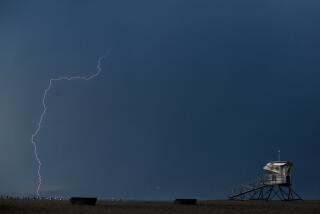Two weather systems stoke furious winds
- Share via
The winds reached 97 mph at one mountain peak. More than 380,000 homes lost power. Thousands of trees snapped, blocking roads and damaging property. Scores of schools were closed, as was Griffith Park. And motorists battled gridlock caused by broken traffic signals and blowing debris.
The storm, which produced some of the strongest wind gusts in more than a decade, was caused by a highly unusual weather system that even had experts marveling at its power.
While Santa Ana winds are common this time of year, this storm was anything but.
The winds were produced by two separate weather systems that channeled cold air from the north into the Los Angeles area.
A clockwise high-pressure system was parked over Northern California and the Great Basin as a counter-clockwise low-pressure system hovered over Arizona.
Like two massive gears spinning in opposite directions, the systems funneled the winds.
“In some places we’ve seen gusts over hurricane force, which for the Southwest part of the country is not something that usually happens,” said Brian Edwards, a meteorologist for AccuWeather.com. “This is a one-every-10-years kind of thing.”
Indeed, the blustery conditions extended across the Southwest, including Utah, Nevada, Wyoming, Arizona and New Mexico. In some places, including Utah, wind gusts topped 100 mph.
Experts said one reason for the extensive damage was that the winds were remarkably choppy and unpredictable.
In some places, winds suddenly shifted from 10 mph or 20 mph to more than 80 mph. The shift made trees as well as roofs and power lines vulnerable.
“Everything lined up perfectly,” said Bill Patzert, a climatologist for Jet Propulsion Laboratory in La Canada-Flintridge.
Trees were no match for the winds, especially those with heavy canopies. Patzert noted that trees in urban Southern California neighborhoods don’t have the strong root systems found in more natural environments.
“L.A. trees don’t have deep roots. The urban forest is artificial and is primarily watered by lawn sprinklers,” Patzert said. “So what keeps our urban forest alive is people watering their lawns, which are not natural, so you don’t have deep root systems. So our trees are very vulnerable to Santa Ana events.”
Walter Warriner, a Santa Monica arborist and community forester, agreed, adding that the large canopies of many local trees lack strong foundations.
“When you look at a tree above ground there’s a ratio of 20 to 1 compared to below ground, so there’s not that many roots holding our big trees in place,” he said.
While damage was reported across the Southland, communities in the western San Gabriel Valley were particularly hard-hit, including Pasadena, South Pasadena, San Marino, Altadena and La Canada-Flintridge.
National Weather Service meteorologist Eric Boldt said this, too, was unusual.
Typically, the San Fernando Valley and Ventura County get the brunt of such windstorms.
But Boldt said that these Santa Ana winds came more directly from the north rather than from the northeast.
The air was colder than the traditional Santa Anas, causing the winds to sink to lower elevations.
“You’ve got that air building up on the other side of the mountains right there above Pasadena, and then it comes like a bowling ball rolling down the hillsides right into the lower elevations,” he said.
“Colder air is going to sink a lot faster. In a typical Santa Ana, the winds will be up high, and not really get down to where we live.”
Another factor was the difference in the levels of pressure between the two weather systems.
“The stronger the difference, the stronger the winds. In this case, we had a very strong difference in pressure,” Edwards said. “Add in the terrain, the mountain passes, the canyons and things like that, and you get these local enhancements, like a funneling effect, which in turn creates even stronger winds.”
The winds are expected to stay through Friday, gradually losing their strength.
But Patzert said the region should not get comfortable just yet.
“This is not going away any time soon,” he said. “This is local. This is not global warming or El Nino or La Nina or anything like that.
“These are Santa Anas and this is the time of the year they occur.”
--
More to Read
Sign up for Essential California
The most important California stories and recommendations in your inbox every morning.
You may occasionally receive promotional content from the Los Angeles Times.












